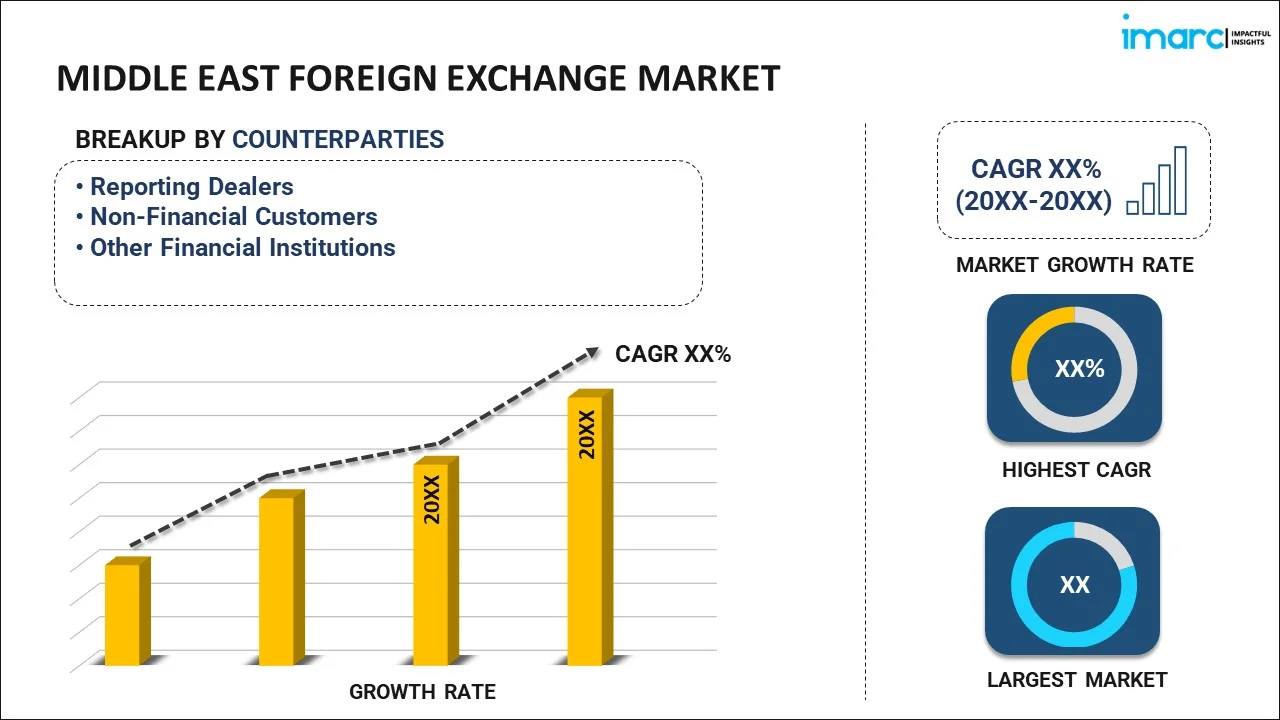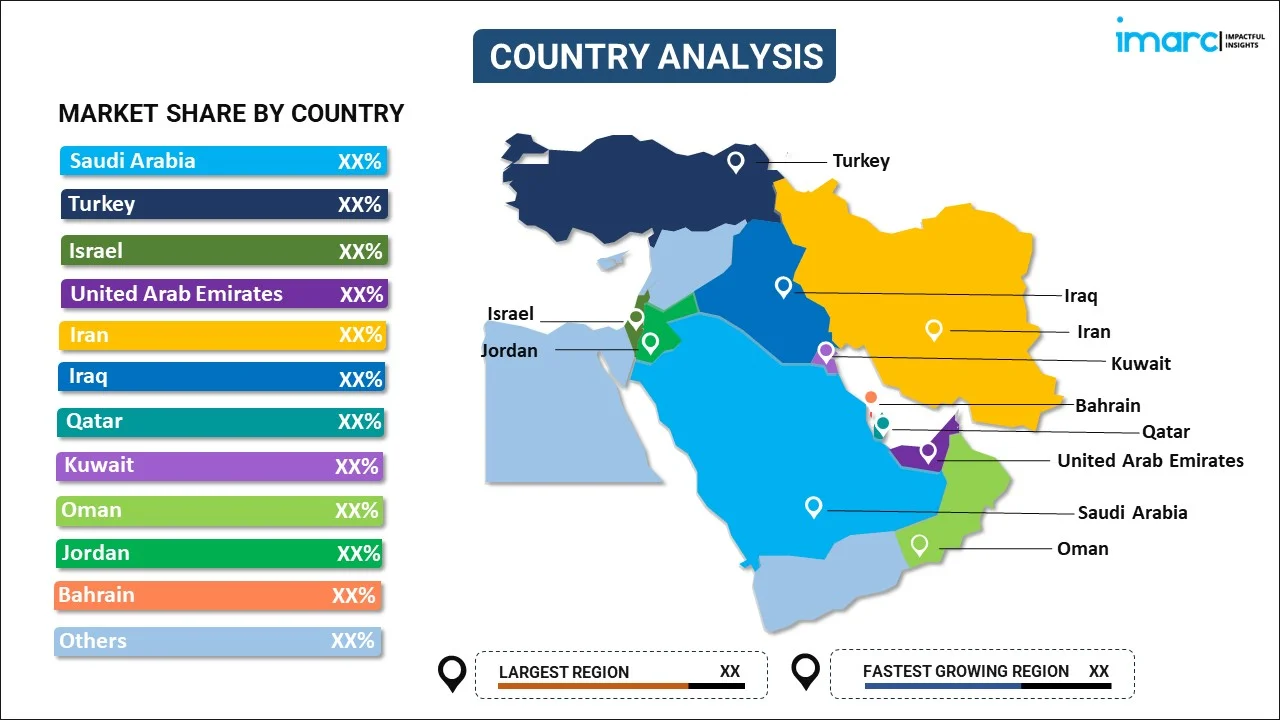
Middle East Foreign Exchange Market Report by Counterparty (Reporting Dealers, Non-Financial Customers, Other Financial Institutions), Type (Currency Swap, Outright Forward and FX Swaps, FX Options), and Country 2024-2032
Market Overview:
Middle East foreign exchange market size is projected to exhibit a growth rate (CAGR) of 9.20% during 2024-2032. The expanding travel and tourism industry and the growing investments in the non-oil sectors, such as retail, real estate, finance, etc., are primarily driving the market growth.
|
Report Attribute
|
Key Statistics
|
|---|---|
|
Base Year
|
2023 |
|
Forecast Years
|
2024-2032
|
|
Historical Years
|
2018-2023
|
| Market Growth Rate (2024-2032) | 9.20% |
Foreign exchange, commonly known as forex or FX, is the global platform where national currencies are exchanged. This market stands as the largest and most fluid financial arena globally. In the realm of foreign exchange, various entities such as banks, corporations, and individuals engage in the buying, selling, and speculation of currency pairs. These transactions serve diverse purposes, ranging from facilitating international trade to mitigating currency-related risks and capitalizing on fluctuations in exchange rates. The values of currencies relative to each other, known as exchange rates, continually fluctuate in the forex market, a phenomenon influenced by factors like economic indicators (such as GDP growth rates, inflation, and interest rates), political stability, market sentiment, and geopolitical events. Operating around the clock, five days a week, the forex market caters to the global economy and accommodates participants across different time zones. Consequently, foreign exchange plays a vital role in facilitating seamless financial transactions between countries and economies while providing investors with opportunities to capitalize on shifts in currency values.
Middle East Foreign Exchange Market Trends:
The Middle East foreign exchange market serves as a dynamic and pivotal component within the financial landscape. Boasting a rich tapestry of economic activities, this market operates as a hub for trading national currencies in the region. Additionally, with a diverse array of participants, including central banks, commercial banks, multinational corporations, and individual investors, the Middle East foreign exchange market is characterized by its multifaceted nature. Besides this, transactions within this market are driven by various motives, ranging from facilitating cross-border trade to managing currency risks and pursuing speculative opportunities. Exchange rates in the Middle East are subject to influences such as economic indicators, such as oil prices, a significant factor for oil-exporting nations, political developments, regional stability, and geopolitical events. The decentralized nature of forex trading in the Middle East, occurring over the counter (OTC) rather than on a centralized exchange, provides flexibility and accessibility to a wide range of participants. This, in turn, is expected to fuel the regional market in the coming years.
Middle East Foreign Exchange Market Segmentation:
IMARC Group provides an analysis of the key trends in each segment of the market, along with forecasts at the regional and country levels for 2024-2032. Our report has categorized the market based on counterparty and type.
Counterparty Insights:

- Reporting Dealers
- Non-Financial Customers
- Other Financial Institutions
The report has provided a detailed breakup and analysis of the market based on the counterparty. This includes reporting dealers, non-financial customers, and other financial institutions.
Type Insights:
- Currency Swap
- Outright Forward and FX Swaps
- FX Options
A detailed breakup and analysis of the market based on the type have also been provided in the report. This includes currency swap, outright forward and FX swaps, and FX options.
Country Insights:

- Saudi Arabia
- Turkey
- Israel
- United Arab Emirates
- Iran
- Iraq
- Qatar
- Kuwait
- Oman
- Jordan
- Bahrain
- Others
The report has also provided a comprehensive analysis of all the major regional markets, which include Saudi Arabia, Turkey, Israel, United Arab Emirates, Iran, Iraq, Qatar, Kuwait, Oman, Jordan, Bahrain, and Others.
Competitive Landscape:
The market research report has also provided a comprehensive analysis of the competitive landscape in the market. Competitive analysis such as market structure, key player positioning, top winning strategies, competitive dashboard, and company evaluation quadrant has been covered in the report. Also, detailed profiles of all major companies have been provided.
Middle East Foreign Exchange Market Report Coverage:
| Report Features | Details |
|---|---|
| Base Year of the Analysis | 2023 |
| Historical Period | 2018-2023 |
| Forecast Period | 2024-2032 |
| Units | US$ Million |
| Scope of the Report | Exploration of Historical and Forecast Trends, Industry Catalysts and Challenges, Segment-Wise Historical and Predictive Market Assessment:
|
| Counterparties Covered | Reporting Dealers, Non-Financial Customers, Other Financial Institutions |
| Types Covered | Currency Swap, Outright Forward and FX Swaps, FX Options |
| Countries Covered | Saudi Arabia, Turkey, Israel, United Arab Emirates, Iran, Iraq, Qatar, Kuwait, Oman, Jordan, Bahrain, Others |
| Customization Scope | 10% Free Customization |
| Report Price and Purchase Option | Single User License: US$ 3699 Five User License: US$ 4699 Corporate License: US$ 5699 |
| Post-Sale Analyst Support | 10-12 Weeks |
| Delivery Format | PDF and Excel through Email (We can also provide the editable version of the report in PPT/Word format on special request) |
Key Questions Answered in This Report:
- How has the Middle East foreign exchange market performed so far and how will it perform in the coming years?
- What has been the impact of COVID-19 on the Middle East foreign exchange market?
- What is the breakup of the Middle East foreign exchange market on the basis of counterparty?
- What is the breakup of the Middle East foreign exchange market on the basis of type?
- What are the various stages in the value chain of the Middle East foreign exchange market?
- What are the key driving factors and challenges in the Middle East foreign exchange?
- What is the structure of the Middle East foreign exchange market and who are the key players?
- What is the degree of competition in the Middle East foreign exchange market?
Key Benefits for Stakeholders:
- IMARC’s industry report offers a comprehensive quantitative analysis of various market segments, historical and current market trends, market forecasts, and dynamics of the Middle East foreign exchange market from 2018-2032.
- The research report provides the latest information on the market drivers, challenges, and opportunities in the Middle East foreign exchange market.
- Porter's five forces analysis assist stakeholders in assessing the impact of new entrants, competitive rivalry, supplier power, buyer power, and the threat of substitution. It helps stakeholders to analyze the level of competition within the Middle East foreign exchange industry and its attractiveness.
- Competitive landscape allows stakeholders to understand their competitive environment and provides an insight into the current positions of key players in the market.
Need more help?
- Speak to our experienced analysts for insights on the current market scenarios.
- Include additional segments and countries to customize the report as per your requirement.
- Gain an unparalleled competitive advantage in your domain by understanding how to utilize the report and positively impacting your operations and revenue.
- For further assistance, please connect with our analysts.
 Inquire Before Buying
Inquire Before Buying
 Speak to an Analyst
Speak to an Analyst
 Request Brochure
Request Brochure
 Request Customization
Request Customization




.webp)




.webp)












